
What is a hydraulic pump repair?
Content
For the car to function properly, all its mechanisms must work properly. A well-functioning vehicle will provide greater travel comfort.
One of the important parts of the car is a hydraulic pump. Depending on the modification of the machine, it performs different functions. For example, it enhances the operation of the steering gear. Some cars are equipped with hydraulic brakes.
The condition of the hydraulic pump should not be underestimated. Regular diagnosis of his condition can guarantee us less problems in the future and save time and money on repairs.
Briefly about the hydraulic pump
A hydraulic pump converts mechanical energy into hydraulic energy, which creates pressure in the direction from the tank to the desired mechanism. For example, in the case of steering, the power steering transforms the rotational movement from the steering wheel to linear, making it easier to perform maneuvers at high speeds.

The hydraulic pump has a number of applications in steering system, hydraulic jack, excavators such as BobCat, JCV, CAT, John Deer, etc., trucks, mixers (fresh concrete transport truck), undercarriage suspension and hydraulic braking systems of cars (e.g. Mercedes ABC).
The main types of hydraulic pumps
Hydraulic pumps come in the following varieties:
- Radial piston;
- Axial piston;
- Piston;
- Rotary (paddle);
- Toothed
- Electro-hydraulic.
In most budget and mid-range vehicles, a hydraulic pump is used in the steering rack to increase rack movement.
How to understand that a hydraulic pump needs repair?
Constant noise from the pump, especially in wet weather or when the steering wheel is turned all the way. This is the most common “symptom” of a failed power steering pump. Here are some reasons that can lead to this effect:
- One of the pump bearings is worn;
- The belt pulley does not rotate.
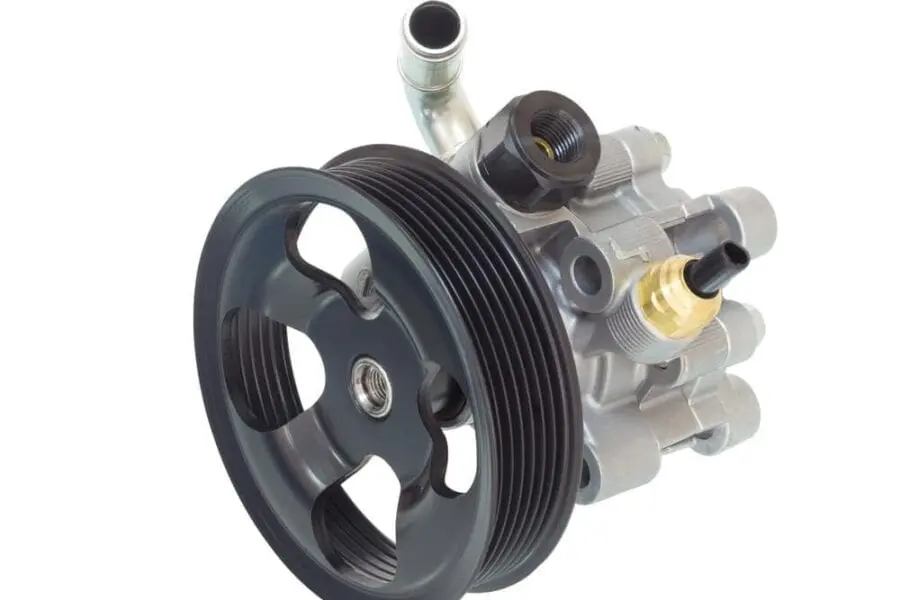
Loud noise and knock when turning. The reasons for this may be:
- The pump does not provide the required hydraulic pressure in the rack;
- Pump malfunction;
- Hydraulic fluid leaked out;
- Partially or completely torn anther;
- Oil leakage into the rack rack cavity;
- Pump runs without oil suction
It is also necessary to pay attention to the hydraulic pump when it is difficult to turn the steering wheel or when the car is driving in one direction.
When it comes to repairing a hydraulic pump, it is recommended that you first consult a specialist. The service center will conduct a more accurate diagnosis of the condition of the hydraulic pump and the type of repair it needs. If you nevertheless decided to repair it yourself and already had experience in such repairs, we offer you the following steps.
How to repair a hydraulic pump yourself?
Repair should not be difficult if the problem is only in the shaft or bearing, and if we have a suitable clamp to remove the washer or screw press. Since the washer is fixed in the axis of the assembly by hot pressing, a lot of effort must be made to remove it and then move it to the side. For this purpose, do not use a hammer.
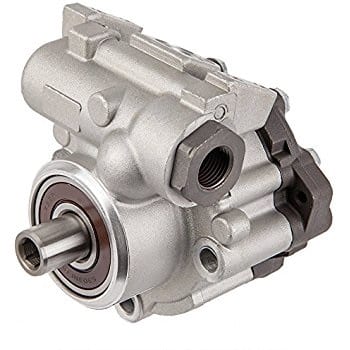
Repair step by step
- Remove the pump;
- To clear of oil and dirt;
- Remove the back cover after removing the snap ring. It is easy to remove, since there is a technological hole in the lid for easier removal of the ring.
- Slowly and carefully remove the cover to remove all internal parts of the pump and see in what order they are assembled. You need to pay attention to how the case is assembled and installed.
- Carefully remove the inside of the pump, describing the sequence and direction of the removed items. At this moment, it is not recommended to wash or degrease the surfaces, because rusty spots will appear on the plates and other elements.
- We check for mechanical damage or tears on the working surfaces. If we find any problems, it makes no sense to move on to the next steps, but it is better to install a new pump.
- The next step is to tighten the shaft with the bearing. At the same time, be careful not to damage the tail of the axle, as it is located in the needle bearing in the rear cover. This bearing is usually not replaced.
- Now we need to knock out a screw press or bearing with a sleeve holding the washer. The lower bearing ring serves as a support and also supports the sleeve. It is recommended to heat the bushing with a burner, taking care not to let the flame enter the shaft.
- Replace the bearing and seal with new ones.
- Using a burner, heat the washer bushing to a cherry red color and quickly insert the bushing into the shaft. To do this, we need a press, as in this procedure we need to make great efforts. The plane must be flush with the front of the shaft.
- Flush the inside of the pump with kerosene and lubricate it with hydraulic oil or for automatic transmissions.
- Install the gland.
- Wash the shaft with kerosene and oil it.
- Wash all internal components and then lubricate. Carefully install all the parts in the reverse order.
- Carefully press the cover and install the snap ring.
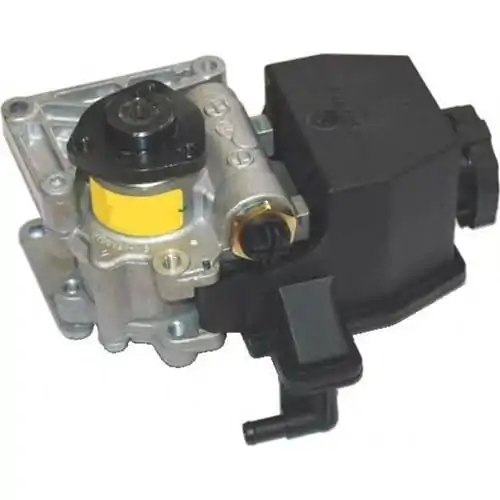
Now it remains to install the pump on the car and fill the tank to the brim with oil designed for automatic transmissions. Depending on the system, about 1 liter of oil will be required. Then we briefly start the car and make several full turns of the steering wheel left and right.
How to extend the life of the hydraulic pump?
- The fluid level in the tank should be monitored regularly.
- Do not turn the steering wheel all the way to protect the rack.
- Perform periodic diagnostics of the hydraulic drive system.
What elements are affected by a malfunction of the hydraulic pump?
Typically, these are pistons, control valves, hydraulic cylinders, seals, nozzles, hoses and teeth.
The hydraulic rack is part of the steering system of many modern cars. It is usually supplied with a hydraulic pump. Depending on the car model, its drive can be hydraulic, mechanical, electromechanical and electric.
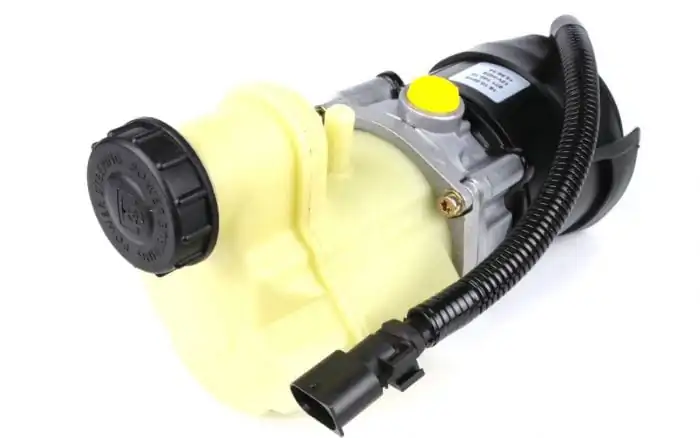
Steering rack
The operation of the steering rack with power steering directly depends on the serviceability of the pump, as well as on the quality of the line. It can be flexible hoses or durable metal pipes. Hydraulic fluid under vacuum and pressure passes through the cavity of the line and moves the rack in the desired direction.
It is absolutely dangerous to drive with a damaged steering rack.
There are three types of steering racks: hydraulic, electrical and mechanical, and the simplest type of rack is a mechanical rack, since it does not have additional force converters, also called amplifiers.
Hydraulic and electric rails have additional rotational reinforcement, which facilitates driving. The hydraulic rack is equipped with a gearbox driven by a pump, and the electric rack has an electric motor.
These two types are becoming more common in a modern car, but their device is becoming more complex and, accordingly, the maintenance of the car itself is becoming more expensive.
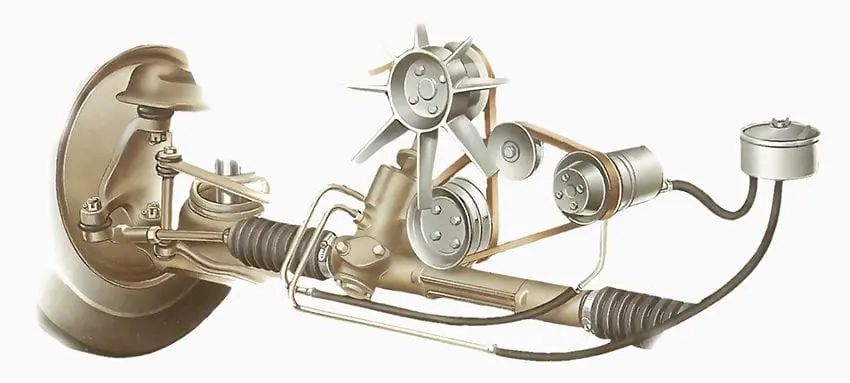
If we decide to repair the rack, we must make sure that our car has a working hydraulic pump and that there is no leakage of hydraulic oil. Otherwise, it is likely that our new rail will break.
Hydraulic valves
Among the parts that are important to a car’s steering system are hydraulic valves. They are responsible for the retention of pressure, direction and outflow of fluids.
Drives
Drives convert hydraulic energy into mechanical energy. Drives are hydraulic cylinders. They are used in agricultural, construction and industrial equipment.
Questions and answers:
How to bleed a hydraulic strut? The locking needle is unscrewed by a couple of turns. The plunger is raised to the highest position and released. This procedure is performed every time oil is poured.
How to fill the hydraulic strut? The fastener is unscrewed and the drain valve with the piston is taken out. The piston is cleaned of dirt, as well as the bleed valve. The oil is drained in the same way as the device is pumped. After that, all seals are changed and the mechanism is washed.

